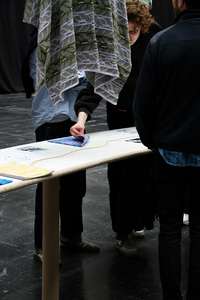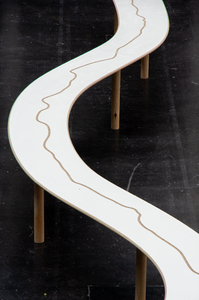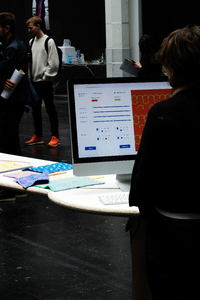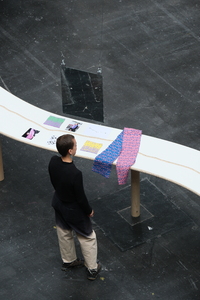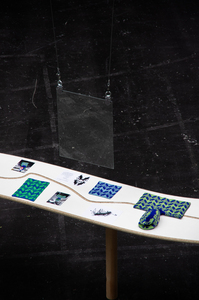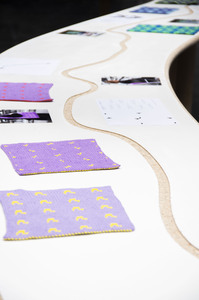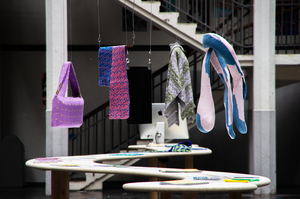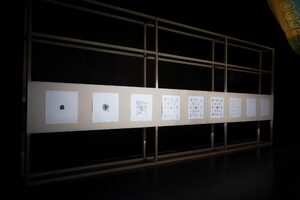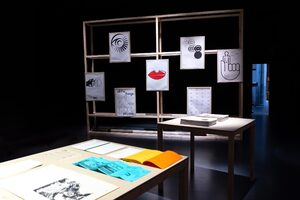"Ausstellung"
| Begriff | Ausstellung |
| Metakey | Typ des Projekts/Werks (creative_work:type) |
| Typ | Keyword |
| Vokabular | Werk |
296 Inhalte
- Seite 1 von 25
Path Tiles - Ausstellung
- Titel
- Path Tiles - Ausstellung
- Autor/in
- Kategorie
- Typ des Projekts/Werks
- Datierung
- April 2024
- Internetlinks
- Titel
- Path Tiles - Ausstellung
- Titel (en)
- Path Tiles - Exhibition
- Urheberrechtshinweis
- Rita Andrulyte
- Rechtsschutz/Lizenz
- Freigabe Nutzung HfG
- Medienersteller/in
- Beziehung/Funktion
- Medien-Beschreibung
- Die Diplomarbeit "Path Tiles" wurde im April 2024 im Lichthof der HfG ausgestellt. Das Herzstück des Displays bildete der 10 Meter lange Tisch, dessen äußere Form an der Route von Litauen nach Deutschland orientiert ist. Zusätzlich wurde diese Route detailgetreu in die Oberfläche gefräst. Sie beschreibt meinen persönlichen Weg der Auswanderung nach Deutschland als ich noch ein Kind war. Die finalen Objekte wurden über dem Tisch aufgehängt während die zugehörigen Geschichten, Muster, Routen und Fotos auf dem Tisch gezeigt wurden.
Ich bedanke mich ganz herzlich für die Umsetzung des Ausstellungsdesigns bei Erik Grunder, Finn de Bruyn, Alexander Knoppik und Sebastian Schäfer.
- Die Diplomarbeit "Path Tiles" wurde im April 2024 im Lichthof der HfG ausgestellt. Das Herzstück des Displays bildete der 10 Meter lange Tisch, dessen äußere Form an der Route von Litauen nach Deutschland orientiert ist. Zusätzlich wurde diese Route detailgetreu in die Oberfläche gefräst. Sie beschreibt meinen persönlichen Weg der Auswanderung nach Deutschland als ich noch ein Kind war. Die finalen Objekte wurden über dem Tisch aufgehängt während die zugehörigen Geschichten, Muster, Routen und Fotos auf dem Tisch gezeigt wurden.
- Medien-Beschreibung (en)
- The diploma “Path Tiles” was exhibited in the atrium of the HfG in April 2024. The centerpiece of the display was the 10-meter-long table, whose outer shape is based on the route from Lithuania to Germany. This route was also milled into the surface in great detail. It describes my personal path of emigration to Germany when I was a child. The final objects were hung above the table while the corresponding stories, patterns, routes and photos were displayed on the table.
I would like to express my sincere thanks for the realization of the exhibition design to Erik Grunder, Finn de Bruyn, Alexander Knoppik and Sebastian Schäfer.
- The diploma “Path Tiles” was exhibited in the atrium of the HfG in April 2024. The centerpiece of the display was the 10-meter-long table, whose outer shape is based on the route from Lithuania to Germany. This route was also milled into the surface in great detail. It describes my personal path of emigration to Germany when I was a child. The final objects were hung above the table while the corresponding stories, patterns, routes and photos were displayed on the table.
- Projektleiter/in
- Semester
- Studiengang
- Typ der Abschlussarbeit
- Importiert am
- 29.05.2024
- Übergeordnete Sets
- 1
Path Tiles - Ausstellung
- Titel
- Path Tiles - Ausstellung
- Autor/in
- Kategorie
- Typ des Projekts/Werks
- Datierung
- April 2024
- Internetlinks
- Titel
- Path Tiles - Ausstellung
- Titel (en)
- Path Tiles - Exhibition
- Urheberrechtshinweis
- Rita Andrulyte
- Rechtsschutz/Lizenz
- Freigabe Nutzung HfG
- Medienersteller/in
- Beziehung/Funktion
- Medien-Beschreibung
- Die Diplomarbeit "Path Tiles" wurde im April 2024 im Lichthof der HfG ausgestellt. Das Herzstück des Displays bildete der 10 Meter lange Tisch, dessen äußere Form an der Route von Litauen nach Deutschland orientiert ist. Zusätzlich wurde diese Route detailgetreu in die Oberfläche gefräst. Sie beschreibt meinen persönlichen Weg der Auswanderung nach Deutschland als ich noch ein Kind war. Die finalen Objekte wurden über dem Tisch aufgehängt während die zugehörigen Geschichten, Muster, Routen und Fotos auf dem Tisch gezeigt wurden.
Ich bedanke mich ganz herzlich für die Umsetzung des Ausstellungsdesigns bei Erik Grunder, Finn de Bruyn, Alexander Knoppik und Sebastian Schäfer.
- Die Diplomarbeit "Path Tiles" wurde im April 2024 im Lichthof der HfG ausgestellt. Das Herzstück des Displays bildete der 10 Meter lange Tisch, dessen äußere Form an der Route von Litauen nach Deutschland orientiert ist. Zusätzlich wurde diese Route detailgetreu in die Oberfläche gefräst. Sie beschreibt meinen persönlichen Weg der Auswanderung nach Deutschland als ich noch ein Kind war. Die finalen Objekte wurden über dem Tisch aufgehängt während die zugehörigen Geschichten, Muster, Routen und Fotos auf dem Tisch gezeigt wurden.
- Medien-Beschreibung (en)
- The diploma “Path Tiles” was exhibited in the atrium of the HfG in April 2024. The centerpiece of the display was the 10-meter-long table, whose outer shape is based on the route from Lithuania to Germany. This route was also milled into the surface in great detail. It describes my personal path of emigration to Germany when I was a child. The final objects were hung above the table while the corresponding stories, patterns, routes and photos were displayed on the table.
I would like to express my sincere thanks for the realization of the exhibition design to Erik Grunder, Finn de Bruyn, Alexander Knoppik and Sebastian Schäfer.
- The diploma “Path Tiles” was exhibited in the atrium of the HfG in April 2024. The centerpiece of the display was the 10-meter-long table, whose outer shape is based on the route from Lithuania to Germany. This route was also milled into the surface in great detail. It describes my personal path of emigration to Germany when I was a child. The final objects were hung above the table while the corresponding stories, patterns, routes and photos were displayed on the table.
- Projektleiter/in
- Semester
- Studiengang
- Typ der Abschlussarbeit
- Importiert am
- 29.05.2024
- Übergeordnete Sets
- 1
Path Tiles - Ausstellung
- Titel
- Path Tiles - Ausstellung
- Autor/in
- Kategorie
- Typ des Projekts/Werks
- Datierung
- April 2024
- Internetlinks
- Titel
- Path Tiles - Ausstellung
- Titel (en)
- Path Tiles - Exhibition
- Urheberrechtshinweis
- Rita Andrulyte
- Rechtsschutz/Lizenz
- Freigabe Nutzung HfG
- Medienersteller/in
- Beziehung/Funktion
- Medien-Beschreibung
- Die Diplomarbeit "Path Tiles" wurde im April 2024 im Lichthof der HfG ausgestellt. Das Herzstück des Displays bildete der 10 Meter lange Tisch, dessen äußere Form an der Route von Litauen nach Deutschland orientiert ist. Zusätzlich wurde diese Route detailgetreu in die Oberfläche gefräst. Sie beschreibt meinen persönlichen Weg der Auswanderung nach Deutschland als ich noch ein Kind war. Die finalen Objekte wurden über dem Tisch aufgehängt während die zugehörigen Geschichten, Muster, Routen und Fotos auf dem Tisch gezeigt wurden.
Ich bedanke mich ganz herzlich für die Umsetzung des Ausstellungsdesigns bei Erik Grunder, Finn de Bruyn, Alexander Knoppik und Sebastian Schäfer.
- Die Diplomarbeit "Path Tiles" wurde im April 2024 im Lichthof der HfG ausgestellt. Das Herzstück des Displays bildete der 10 Meter lange Tisch, dessen äußere Form an der Route von Litauen nach Deutschland orientiert ist. Zusätzlich wurde diese Route detailgetreu in die Oberfläche gefräst. Sie beschreibt meinen persönlichen Weg der Auswanderung nach Deutschland als ich noch ein Kind war. Die finalen Objekte wurden über dem Tisch aufgehängt während die zugehörigen Geschichten, Muster, Routen und Fotos auf dem Tisch gezeigt wurden.
- Medien-Beschreibung (en)
- The diploma “Path Tiles” was exhibited in the atrium of the HfG in April 2024. The centerpiece of the display was the 10-meter-long table, whose outer shape is based on the route from Lithuania to Germany. This route was also milled into the surface in great detail. It describes my personal path of emigration to Germany when I was a child. The final objects were hung above the table while the corresponding stories, patterns, routes and photos were displayed on the table.
I would like to express my sincere thanks for the realization of the exhibition design to Erik Grunder, Finn de Bruyn, Alexander Knoppik and Sebastian Schäfer.
- The diploma “Path Tiles” was exhibited in the atrium of the HfG in April 2024. The centerpiece of the display was the 10-meter-long table, whose outer shape is based on the route from Lithuania to Germany. This route was also milled into the surface in great detail. It describes my personal path of emigration to Germany when I was a child. The final objects were hung above the table while the corresponding stories, patterns, routes and photos were displayed on the table.
- Projektleiter/in
- Semester
- Studiengang
- Typ der Abschlussarbeit
- Importiert am
- 29.05.2024
- Übergeordnete Sets
- 1
Path Tiles - Ausstellung
- Titel
- Path Tiles - Ausstellung
- Autor/in
- Kategorie
- Typ des Projekts/Werks
- Datierung
- April 2024
- Internetlinks
- Titel
- Path Tiles - Ausstellung
- Titel (en)
- Path Tiles - Exhibition
- Urheberrechtshinweis
- Rita Andrulyte
- Rechtsschutz/Lizenz
- Freigabe Nutzung HfG
- Medienersteller/in
- Beziehung/Funktion
- Medien-Beschreibung
- Die Diplomarbeit "Path Tiles" wurde im April 2024 im Lichthof der HfG ausgestellt. Das Herzstück des Displays bildete der 10 Meter lange Tisch, dessen äußere Form an der Route von Litauen nach Deutschland orientiert ist. Zusätzlich wurde diese Route detailgetreu in die Oberfläche gefräst. Sie beschreibt meinen persönlichen Weg der Auswanderung nach Deutschland als ich noch ein Kind war. Die finalen Objekte wurden über dem Tisch aufgehängt während die zugehörigen Geschichten, Muster, Routen und Fotos auf dem Tisch gezeigt wurden.
Ich bedanke mich ganz herzlich für die Umsetzung des Ausstellungsdesigns bei Erik Grunder, Finn de Bruyn, Alexander Knoppik und Sebastian Schäfer.
- Die Diplomarbeit "Path Tiles" wurde im April 2024 im Lichthof der HfG ausgestellt. Das Herzstück des Displays bildete der 10 Meter lange Tisch, dessen äußere Form an der Route von Litauen nach Deutschland orientiert ist. Zusätzlich wurde diese Route detailgetreu in die Oberfläche gefräst. Sie beschreibt meinen persönlichen Weg der Auswanderung nach Deutschland als ich noch ein Kind war. Die finalen Objekte wurden über dem Tisch aufgehängt während die zugehörigen Geschichten, Muster, Routen und Fotos auf dem Tisch gezeigt wurden.
- Medien-Beschreibung (en)
- The diploma “Path Tiles” was exhibited in the atrium of the HfG in April 2024. The centerpiece of the display was the 10-meter-long table, whose outer shape is based on the route from Lithuania to Germany. This route was also milled into the surface in great detail. It describes my personal path of emigration to Germany when I was a child. The final objects were hung above the table while the corresponding stories, patterns, routes and photos were displayed on the table.
I would like to express my sincere thanks for the realization of the exhibition design to Erik Grunder, Finn de Bruyn, Alexander Knoppik and Sebastian Schäfer.
- The diploma “Path Tiles” was exhibited in the atrium of the HfG in April 2024. The centerpiece of the display was the 10-meter-long table, whose outer shape is based on the route from Lithuania to Germany. This route was also milled into the surface in great detail. It describes my personal path of emigration to Germany when I was a child. The final objects were hung above the table while the corresponding stories, patterns, routes and photos were displayed on the table.
- Projektleiter/in
- Semester
- Studiengang
- Typ der Abschlussarbeit
- Importiert am
- 29.05.2024
- Übergeordnete Sets
- 1
Path Tiles - Ausstellung
- Titel
- Path Tiles - Ausstellung
- Autor/in
- Kategorie
- Typ des Projekts/Werks
- Datierung
- April 2024
- Internetlinks
- Titel
- Path Tiles - Ausstellung
- Titel (en)
- Path Tiles - Exhibition
- Urheberrechtshinweis
- Rita Andrulyte
- Rechtsschutz/Lizenz
- Freigabe Nutzung HfG
- Medienersteller/in
- Beziehung/Funktion
- Medien-Beschreibung
- Die Diplomarbeit "Path Tiles" wurde im April 2024 im Lichthof der HfG ausgestellt. Das Herzstück des Displays bildete der 10 Meter lange Tisch, dessen äußere Form an der Route von Litauen nach Deutschland orientiert ist. Zusätzlich wurde diese Route detailgetreu in die Oberfläche gefräst. Sie beschreibt meinen persönlichen Weg der Auswanderung nach Deutschland als ich noch ein Kind war. Die finalen Objekte wurden über dem Tisch aufgehängt während die zugehörigen Geschichten, Muster, Routen und Fotos auf dem Tisch gezeigt wurden.
Ich bedanke mich ganz herzlich für die Umsetzung des Ausstellungsdesigns bei Erik Grunder, Finn de Bruyn, Alexander Knoppik und Sebastian Schäfer.
- Die Diplomarbeit "Path Tiles" wurde im April 2024 im Lichthof der HfG ausgestellt. Das Herzstück des Displays bildete der 10 Meter lange Tisch, dessen äußere Form an der Route von Litauen nach Deutschland orientiert ist. Zusätzlich wurde diese Route detailgetreu in die Oberfläche gefräst. Sie beschreibt meinen persönlichen Weg der Auswanderung nach Deutschland als ich noch ein Kind war. Die finalen Objekte wurden über dem Tisch aufgehängt während die zugehörigen Geschichten, Muster, Routen und Fotos auf dem Tisch gezeigt wurden.
- Medien-Beschreibung (en)
- The diploma “Path Tiles” was exhibited in the atrium of the HfG in April 2024. The centerpiece of the display was the 10-meter-long table, whose outer shape is based on the route from Lithuania to Germany. This route was also milled into the surface in great detail. It describes my personal path of emigration to Germany when I was a child. The final objects were hung above the table while the corresponding stories, patterns, routes and photos were displayed on the table.
I would like to express my sincere thanks for the realization of the exhibition design to Erik Grunder, Finn de Bruyn, Alexander Knoppik and Sebastian Schäfer.
- The diploma “Path Tiles” was exhibited in the atrium of the HfG in April 2024. The centerpiece of the display was the 10-meter-long table, whose outer shape is based on the route from Lithuania to Germany. This route was also milled into the surface in great detail. It describes my personal path of emigration to Germany when I was a child. The final objects were hung above the table while the corresponding stories, patterns, routes and photos were displayed on the table.
- Projektleiter/in
- Semester
- Studiengang
- Typ der Abschlussarbeit
- Importiert am
- 29.05.2024
- Übergeordnete Sets
- 1
Path Tiles - Ausstellung
- Titel
- Path Tiles - Ausstellung
- Autor/in
- Kategorie
- Typ des Projekts/Werks
- Datierung
- April 2024
- Internetlinks
- Titel
- Path Tiles - Ausstellung
- Titel (en)
- Path Tiles - Exhibition
- Urheberrechtshinweis
- Rita Andrulyte
- Rechtsschutz/Lizenz
- Freigabe Nutzung HfG
- Medienersteller/in
- Beziehung/Funktion
- Medien-Beschreibung
- Die Diplomarbeit "Path Tiles" wurde im April 2024 im Lichthof der HfG ausgestellt. Das Herzstück des Displays bildete der 10 Meter lange Tisch, dessen äußere Form an der Route von Litauen nach Deutschland orientiert ist. Zusätzlich wurde diese Route detailgetreu in die Oberfläche gefräst. Sie beschreibt meinen persönlichen Weg der Auswanderung nach Deutschland als ich noch ein Kind war. Die finalen Objekte wurden über dem Tisch aufgehängt während die zugehörigen Geschichten, Muster, Routen und Fotos auf dem Tisch gezeigt wurden.
Ich bedanke mich ganz herzlich für die Umsetzung des Ausstellungsdesigns bei Erik Grunder, Finn de Bruyn, Alexander Knoppik und Sebastian Schäfer.
- Die Diplomarbeit "Path Tiles" wurde im April 2024 im Lichthof der HfG ausgestellt. Das Herzstück des Displays bildete der 10 Meter lange Tisch, dessen äußere Form an der Route von Litauen nach Deutschland orientiert ist. Zusätzlich wurde diese Route detailgetreu in die Oberfläche gefräst. Sie beschreibt meinen persönlichen Weg der Auswanderung nach Deutschland als ich noch ein Kind war. Die finalen Objekte wurden über dem Tisch aufgehängt während die zugehörigen Geschichten, Muster, Routen und Fotos auf dem Tisch gezeigt wurden.
- Medien-Beschreibung (en)
- The diploma “Path Tiles” was exhibited in the atrium of the HfG in April 2024. The centerpiece of the display was the 10-meter-long table, whose outer shape is based on the route from Lithuania to Germany. This route was also milled into the surface in great detail. It describes my personal path of emigration to Germany when I was a child. The final objects were hung above the table while the corresponding stories, patterns, routes and photos were displayed on the table.
I would like to express my sincere thanks for the realization of the exhibition design to Erik Grunder, Finn de Bruyn, Alexander Knoppik and Sebastian Schäfer.
- The diploma “Path Tiles” was exhibited in the atrium of the HfG in April 2024. The centerpiece of the display was the 10-meter-long table, whose outer shape is based on the route from Lithuania to Germany. This route was also milled into the surface in great detail. It describes my personal path of emigration to Germany when I was a child. The final objects were hung above the table while the corresponding stories, patterns, routes and photos were displayed on the table.
- Projektleiter/in
- Semester
- Studiengang
- Typ der Abschlussarbeit
- Importiert am
- 29.05.2024
- Übergeordnete Sets
- 1
Path Tiles - Ausstellung
- Titel
- Path Tiles - Ausstellung
- Autor/in
- Kategorie
- Typ des Projekts/Werks
- Datierung
- April 2024
- Internetlinks
- Titel
- Path Tiles - Ausstellung
- Titel (en)
- Path Tiles - Exhibition
- Urheberrechtshinweis
- Rita Andrulyte
- Rechtsschutz/Lizenz
- Freigabe Nutzung HfG
- Medienersteller/in
- Beziehung/Funktion
- Medien-Beschreibung
- Die Diplomarbeit "Path Tiles" wurde im April 2024 im Lichthof der HfG ausgestellt. Das Herzstück des Displays bildete der 10 Meter lange Tisch, dessen äußere Form an der Route von Litauen nach Deutschland orientiert ist. Zusätzlich wurde diese Route detailgetreu in die Oberfläche gefräst. Sie beschreibt meinen persönlichen Weg der Auswanderung nach Deutschland als ich noch ein Kind war. Die finalen Objekte wurden über dem Tisch aufgehängt während die zugehörigen Geschichten, Muster, Routen und Fotos auf dem Tisch gezeigt wurden.
Ich bedanke mich ganz herzlich für die Umsetzung des Ausstellungsdesigns bei Erik Grunder, Finn de Bruyn, Alexander Knoppik und Sebastian Schäfer.
- Die Diplomarbeit "Path Tiles" wurde im April 2024 im Lichthof der HfG ausgestellt. Das Herzstück des Displays bildete der 10 Meter lange Tisch, dessen äußere Form an der Route von Litauen nach Deutschland orientiert ist. Zusätzlich wurde diese Route detailgetreu in die Oberfläche gefräst. Sie beschreibt meinen persönlichen Weg der Auswanderung nach Deutschland als ich noch ein Kind war. Die finalen Objekte wurden über dem Tisch aufgehängt während die zugehörigen Geschichten, Muster, Routen und Fotos auf dem Tisch gezeigt wurden.
- Medien-Beschreibung (en)
- The diploma “Path Tiles” was exhibited in the atrium of the HfG in April 2024. The centerpiece of the display was the 10-meter-long table, whose outer shape is based on the route from Lithuania to Germany. This route was also milled into the surface in great detail. It describes my personal path of emigration to Germany when I was a child. The final objects were hung above the table while the corresponding stories, patterns, routes and photos were displayed on the table.
I would like to express my sincere thanks for the realization of the exhibition design to Erik Grunder, Finn de Bruyn, Alexander Knoppik and Sebastian Schäfer.
- The diploma “Path Tiles” was exhibited in the atrium of the HfG in April 2024. The centerpiece of the display was the 10-meter-long table, whose outer shape is based on the route from Lithuania to Germany. This route was also milled into the surface in great detail. It describes my personal path of emigration to Germany when I was a child. The final objects were hung above the table while the corresponding stories, patterns, routes and photos were displayed on the table.
- Projektleiter/in
- Semester
- Studiengang
- Typ der Abschlussarbeit
- Importiert am
- 29.05.2024
- Übergeordnete Sets
- 1
Path Tiles - Ausstellung
- Titel
- Path Tiles - Ausstellung
- Autor/in
- Kategorie
- Typ des Projekts/Werks
- Datierung
- April 2024
- Internetlinks
- Titel
- Path Tiles - Ausstellung
- Titel (en)
- Path Tiles - Exhibition
- Urheberrechtshinweis
- Rita Andrulyte
- Rechtsschutz/Lizenz
- Freigabe Nutzung HfG
- Medienersteller/in
- Beziehung/Funktion
- Medien-Beschreibung
- Die Diplomarbeit "Path Tiles" wurde im April 2024 im Lichthof der HfG ausgestellt. Das Herzstück des Displays bildete der 10 Meter lange Tisch, dessen äußere Form an der Route von Litauen nach Deutschland orientiert ist. Zusätzlich wurde diese Route detailgetreu in die Oberfläche gefräst. Sie beschreibt meinen persönlichen Weg der Auswanderung nach Deutschland als ich noch ein Kind war. Die finalen Objekte wurden über dem Tisch aufgehängt während die zugehörigen Geschichten, Muster, Routen und Fotos auf dem Tisch gezeigt wurden.
Ich bedanke mich ganz herzlich für die Umsetzung des Ausstellungsdesigns bei Erik Grunder, Finn de Bruyn, Alexander Knoppik und Sebastian Schäfer.
- Die Diplomarbeit "Path Tiles" wurde im April 2024 im Lichthof der HfG ausgestellt. Das Herzstück des Displays bildete der 10 Meter lange Tisch, dessen äußere Form an der Route von Litauen nach Deutschland orientiert ist. Zusätzlich wurde diese Route detailgetreu in die Oberfläche gefräst. Sie beschreibt meinen persönlichen Weg der Auswanderung nach Deutschland als ich noch ein Kind war. Die finalen Objekte wurden über dem Tisch aufgehängt während die zugehörigen Geschichten, Muster, Routen und Fotos auf dem Tisch gezeigt wurden.
- Medien-Beschreibung (en)
- The diploma “Path Tiles” was exhibited in the atrium of the HfG in April 2024. The centerpiece of the display was the 10-meter-long table, whose outer shape is based on the route from Lithuania to Germany. This route was also milled into the surface in great detail. It describes my personal path of emigration to Germany when I was a child. The final objects were hung above the table while the corresponding stories, patterns, routes and photos were displayed on the table.
I would like to express my sincere thanks for the realization of the exhibition design to Erik Grunder, Finn de Bruyn, Alexander Knoppik and Sebastian Schäfer.
- The diploma “Path Tiles” was exhibited in the atrium of the HfG in April 2024. The centerpiece of the display was the 10-meter-long table, whose outer shape is based on the route from Lithuania to Germany. This route was also milled into the surface in great detail. It describes my personal path of emigration to Germany when I was a child. The final objects were hung above the table while the corresponding stories, patterns, routes and photos were displayed on the table.
- Projektleiter/in
- Semester
- Studiengang
- Typ der Abschlussarbeit
- Importiert am
- 29.05.2024
- Übergeordnete Sets
- 1
Path Tiles - Ausstellung
- Titel
- Path Tiles - Ausstellung
- Autor/in
- Kategorie
- Typ des Projekts/Werks
- Datierung
- April 2024
- Internetlinks
- Titel
- Path Tiles - Ausstellung
- Titel (en)
- Path Tiles - Exhibition
- Urheberrechtshinweis
- Rita Andrulyte
- Rechtsschutz/Lizenz
- Freigabe Nutzung HfG
- Medienersteller/in
- Beziehung/Funktion
- Medien-Beschreibung
- Die Diplomarbeit "Path Tiles" wurde im April 2024 im Lichthof der HfG ausgestellt. Das Herzstück des Displays bildete der 10 Meter lange Tisch, dessen äußere Form an der Route von Litauen nach Deutschland orientiert ist. Zusätzlich wurde diese Route detailgetreu in die Oberfläche gefräst. Sie beschreibt meinen persönlichen Weg der Auswanderung nach Deutschland als ich noch ein Kind war. Die finalen Objekte wurden über dem Tisch aufgehängt während die zugehörigen Geschichten, Muster, Routen und Fotos auf dem Tisch gezeigt wurden.
Ich bedanke mich ganz herzlich für die Umsetzung des Ausstellungsdesigns bei Erik Grunder, Finn de Bruyn, Alexander Knoppik und Sebastian Schäfer.
- Die Diplomarbeit "Path Tiles" wurde im April 2024 im Lichthof der HfG ausgestellt. Das Herzstück des Displays bildete der 10 Meter lange Tisch, dessen äußere Form an der Route von Litauen nach Deutschland orientiert ist. Zusätzlich wurde diese Route detailgetreu in die Oberfläche gefräst. Sie beschreibt meinen persönlichen Weg der Auswanderung nach Deutschland als ich noch ein Kind war. Die finalen Objekte wurden über dem Tisch aufgehängt während die zugehörigen Geschichten, Muster, Routen und Fotos auf dem Tisch gezeigt wurden.
- Medien-Beschreibung (en)
- The diploma “Path Tiles” was exhibited in the atrium of the HfG in April 2024. The centerpiece of the display was the 10-meter-long table, whose outer shape is based on the route from Lithuania to Germany. This route was also milled into the surface in great detail. It describes my personal path of emigration to Germany when I was a child. The final objects were hung above the table while the corresponding stories, patterns, routes and photos were displayed on the table.
I would like to express my sincere thanks for the realization of the exhibition design to Erik Grunder, Finn de Bruyn, Alexander Knoppik and Sebastian Schäfer.
- The diploma “Path Tiles” was exhibited in the atrium of the HfG in April 2024. The centerpiece of the display was the 10-meter-long table, whose outer shape is based on the route from Lithuania to Germany. This route was also milled into the surface in great detail. It describes my personal path of emigration to Germany when I was a child. The final objects were hung above the table while the corresponding stories, patterns, routes and photos were displayed on the table.
- Projektleiter/in
- Semester
- Studiengang
- Typ der Abschlussarbeit
- Importiert am
- 29.05.2024
- Übergeordnete Sets
- 1
Path Tiles - Ausstellung
- Titel
- Path Tiles - Ausstellung
- Autor/in
- Kategorie
- Typ des Projekts/Werks
- Datierung
- April 2024
- Internetlinks
- Titel
- Path Tiles - Ausstellung
- Titel (en)
- Path Tiles - Exhibition
- Urheberrechtshinweis
- Rita Andrulyte
- Rechtsschutz/Lizenz
- Freigabe Nutzung HfG
- Medienersteller/in
- Beziehung/Funktion
- Medien-Beschreibung
- Die Diplomarbeit "Path Tiles" wurde im April 2024 im Lichthof der HfG ausgestellt. Das Herzstück des Displays bildete der 10 Meter lange Tisch, dessen äußere Form an der Route von Litauen nach Deutschland orientiert ist. Zusätzlich wurde diese Route detailgetreu in die Oberfläche gefräst. Sie beschreibt meinen persönlichen Weg der Auswanderung nach Deutschland als ich noch ein Kind war. Die finalen Objekte wurden über dem Tisch aufgehängt während die zugehörigen Geschichten, Muster, Routen und Fotos auf dem Tisch gezeigt wurden.
Ich bedanke mich ganz herzlich für die Umsetzung des Ausstellungsdesigns bei Erik Grunder, Finn de Bruyn, Alexander Knoppik und Sebastian Schäfer.
- Die Diplomarbeit "Path Tiles" wurde im April 2024 im Lichthof der HfG ausgestellt. Das Herzstück des Displays bildete der 10 Meter lange Tisch, dessen äußere Form an der Route von Litauen nach Deutschland orientiert ist. Zusätzlich wurde diese Route detailgetreu in die Oberfläche gefräst. Sie beschreibt meinen persönlichen Weg der Auswanderung nach Deutschland als ich noch ein Kind war. Die finalen Objekte wurden über dem Tisch aufgehängt während die zugehörigen Geschichten, Muster, Routen und Fotos auf dem Tisch gezeigt wurden.
- Medien-Beschreibung (en)
- The diploma “Path Tiles” was exhibited in the atrium of the HfG in April 2024. The centerpiece of the display was the 10-meter-long table, whose outer shape is based on the route from Lithuania to Germany. This route was also milled into the surface in great detail. It describes my personal path of emigration to Germany when I was a child. The final objects were hung above the table while the corresponding stories, patterns, routes and photos were displayed on the table.
I would like to express my sincere thanks for the realization of the exhibition design to Erik Grunder, Finn de Bruyn, Alexander Knoppik and Sebastian Schäfer.
- The diploma “Path Tiles” was exhibited in the atrium of the HfG in April 2024. The centerpiece of the display was the 10-meter-long table, whose outer shape is based on the route from Lithuania to Germany. This route was also milled into the surface in great detail. It describes my personal path of emigration to Germany when I was a child. The final objects were hung above the table while the corresponding stories, patterns, routes and photos were displayed on the table.
- Projektleiter/in
- Semester
- Studiengang
- Typ der Abschlussarbeit
- Importiert am
- 29.05.2024
- Übergeordnete Sets
- 1
all the things you are.
- Titel
- all the things you are.
- Autor/in
- Kategorie
- Typ des Projekts/Werks
- Schlagworte
- Ort: Institution
- Ort
- Großes Studio
- Stadt
- Land
- Titel
- all the things you are.
- Urheberrechtshinweis
- © Maxim Weirich
- Rechtsschutz/Lizenz
- Freigabe Nutzung HfG
- Medienersteller/in
- Beziehung/Funktion
- Projektleiter/in
- Semester
- Studiengang
- Typ der Abschlussarbeit
- Importiert am
- 14.06.2024
- Übergeordnete Sets
- 1
all the things you are.
- Titel
- all the things you are.
- Autor/in
- Kategorie
- Typ des Projekts/Werks
- Schlagworte
- Ort: Institution
- Ort
- Großes Studio
- Stadt
- Land
- Titel
- all the things you are.
- Urheberrechtshinweis
- © Maxim Weirich
- Rechtsschutz/Lizenz
- Freigabe Nutzung HfG
- Medienersteller/in
- Beziehung/Funktion
- Projektleiter/in
- Semester
- Studiengang
- Typ der Abschlussarbeit
- Importiert am
- 14.06.2024
- Übergeordnete Sets
- 1

